Writing clean and maintainable code is a skill that all developers need to cultivate. By following TypeScript Best Practice guidelines, you ensure your code is not only easier to maintain but also less prone to bugs, making it more readable for yourself and others.. In this guide, we’ll explore some simple yet effective TypeScript Best Practices aimed at beginners.
Why Clean Code Matters
Imagine reading a book where all the pages are out of order, and every sentence is a mix of random letters and punctuation. You wouldn’t be able to make sense of it, right? In programming, messy code is similar. If your code isn’t clean, it’s hard to read, hard to maintain, and it’s more likely to contain bugs. Writing clean code is like keeping your house organized—everything has its place, and it’s easier to navigate.
1. Use Types Generously
One of TypeScript’s Best Practices is leveraging TypeScript’s powerful type system. Unlike JavaScript, where you can assign any value to a variable, TypeScript encourages you to declare types for variables, functions, and objects. This ensures your code is less prone to bugs and easier to maintain.
For example:
// Without type annotations (JavaScript style)
function add(a, b) {
return a + b;
}
// With type annotations (TypeScript style)
function add(a: number, b: number): number {
return a + b;
}
In the first example, the function could accept any type, even strings, which would lead to a bug if a or b was a non-number. In the second example, TypeScript knows that both a and b must be numbered, and it will throw an error if you try to pass anything else.
2. Keep Functions Small and Focused
Another important TypeScript Best Practice is writing small, focused functions. When functions are compact and singular in purpose, they’re easier to test, debug, and maintain.
For example:
// A function trying to do too much
function processData(data: any) {
// validate data
// process data
// format data
// save data
}Instead, break it down into smaller, more focused functions:
function validateData(data: any): boolean {
// validation logic
return true;
}
function processData(data: any): any {
// processing logic
return processedData;
}
function formatData(data: any): string {
// formatting logic
return formattedData;
}
By splitting tasks into small functions, each one becomes easier to test, maintain, and debug.
3. Use Meaningful Names
Naming conventions are an integral part of TypeScript Best Practices. Descriptive and meaningful names help make your code easier to read and understand at a glance.
For example:
// Bad naming
let x = 5;
function fn(y) {
return y * 2;
}
// Good naming
let userAge = 5;
function doubleValue(value: number): number {
return value * 2;
}
In the second example, it’s clear what userAge and doubleValue are supposed to represent. Descriptive names make the code more readable and easier to understand.
4. Leverage TypeScript’s Interfaces and Types
Structuring your code using interfaces and types is one of the most effective TypeScript Best Practices for ensuring readability and maintainability.
For example, if you’re working with objects, use an interface to define the structure:
interface User {
name: string;
age: number;
email: string;
}
function greetUser(user: User) {
console.log(`Hello, ${user.name}`);
}
Now, whenever you use the User object, TypeScript will enforce the structure. If you forget to include age or email, TypeScript will warn you. This makes your code more predictable and easier to maintain.
5. Avoid Any When Possible: A TypeScript Best Practice
TypeScript includes any type, which allows you to bypass type checking. While it can be tempting to use any when you’re unsure of a type, it defeats the purpose of using TypeScript in the first place. Try to be specific about types, and only use any of them as a last resort.
For safer alternatives, explore how to use TypeScript’s Unknown Type.
// Avoid using `any` when you can
function logData(data: any) {
console.log(data);
}
// Better approach
function logData(data: string | number | boolean) {
console.log(data);
}By being explicit about types, you’re helping TypeScript catch potential errors early.
6. Use Optional and Default Parameters
In TypeScript, you can make function parameters optional by using, and you can also assign default values to parameters. This makes your functions more flexible and easier to use.
For example:
function greet(name: string, greeting?: string): void {
console.log(`${greeting || 'Hello'}, ${name}`);
}
greet('Alice'); // Outputs: Hello, Alice
greet('Bob', 'Good morning'); // Outputs: Good morning, Bob
In this example, the greeting parameter is optional, and if it’s not provided, it defaults to 'Hello'.
7. Comment Wisely
Comments can be helpful but don’t overdo them. You want your code to be self-explanatory as much as possible but use comments when you think something might be unclear.
For example:
// Bad comment
let a = 10; // assign 10 to a
// Good comment
let timeout = 1000; // Timeout in milliseconds
Instead of commenting on things that are already obvious, use comments to explain why something is done, not what is being done.
You can read more here about 6 Top Questions for Hiring Web3 Ops Manager
8. Keep Files Small and Organized
As your TypeScript project grows, it’s easy for files to get cluttered with too much code. Keep your files organized by grouping related code, and breaking larger files into smaller, more manageable pieces.
For example, if you have a file that handles both user management and authentication, consider splitting them into separate files:
/src
/user
user.ts
/auth
auth.ts
9. Enable Strict Mode
TypeScript has a feature called strict mode that makes the type-checking process more rigorous. Enabling strict mode helps catch potential issues early in development, making your code safer and less prone to bugs.
You can enable strict mode in your tsconfig.json file:
{
"compilerOptions": {
"strict": true
}
}
This will enforce stricter type checks and make sure you’re following best practices.
You can read more here about: Managed IT Services in Dubai for Business
10. Use ESLint and Prettier
Finally, to maintain consistency and style across your codebase, use tools like ESLint and Prettier. ESLint will help catch common errors, and Prettier will automatically format your code, so you don’t have to worry about style inconsistencies.
You can install these tools using npm:
npm install eslint prettier --save-dev
Final Thoughts on TypeScript Best Practice
Writing clean and maintainable TypeScript code is not just about following rules; it’s about adopting habits that make your life as a developer easier in the long run. By keeping your functions small, using meaningful names, and leveraging TypeScript’s powerful type system, you’ll be on your way to creating code that’s easy to read, maintain, and extend.
Remember, the key to writing good code is clarity. If your code is clear, others (and you, later on) will be able to understand and work with it much more effectively.



